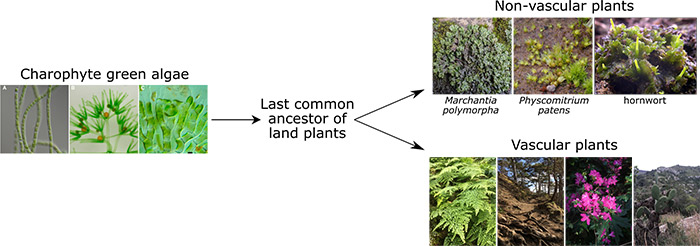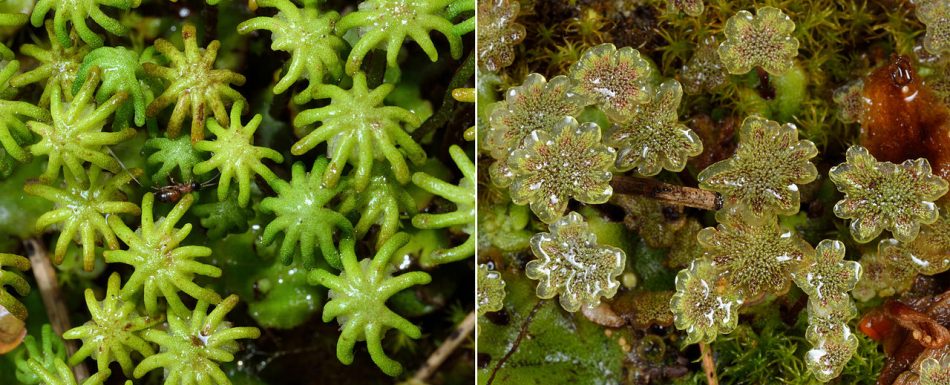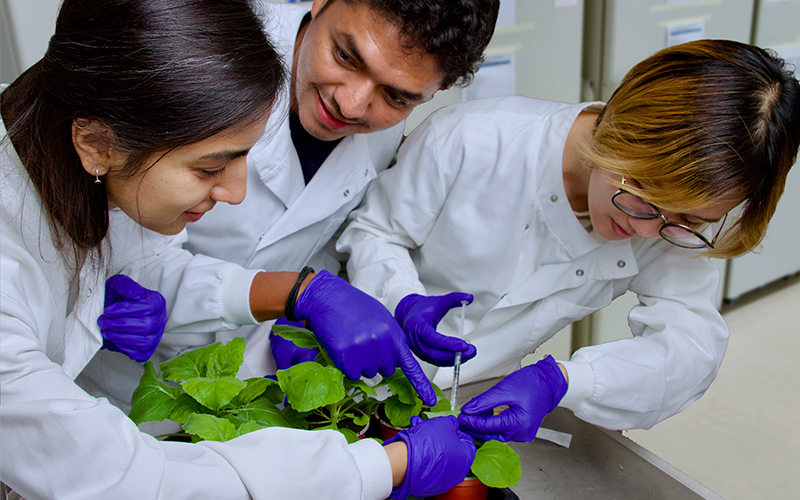
Moss Safari: what lives in moss?
Fantastic beasts: take a microscopic moss safari and learn about the diverse and resilient organisms that live in this challenging habitat.

Plants today are extremely diverse, abundant, and flamboyant. However, the first land plants, which initiated a great change in the flora and fauna on planet Earth, were very different.
In the beginning of the Palaeozoic era, 500 million years ago, the surface of the Earth was covered with water and barren rock and was uninhabitable to modern life forms. The atmosphere contained 20 times more carbon dioxide but only half as much oxygen as today. For large animals living on Earth today, such conditions would be bad news – mitochondria, the powerhouses of the body, need oxygen to provide the energy for life. During the Palaeozoic era, there was not enough oxygen available to satisfy these energy requirements and thus the animals of the early Palaeozoic were small. They also mostly lived in aquatic environments because water filtered out harmful UV radiation. The ozone layer that today protects us from UV radiation requires oxygen to form. It starts with a process called photolysis, where the two oxygen atoms that make up an oxygen molecule (O2) are split apart by energy from sunlight. Then a single oxygen atom combines with another O2 molecule and ozone (O3) is formed:
O + O2 → O3
In the early Palaeozoic, not enough oxygen was available to allow the buildup of ozone.
287 million years later, towards the end of the Palaeozoic era, mid-sized to large animals were thriving in both aquatic and terrestrial habitats. What changed?
The evolution of large animals on land was made possible by the depletion of atmospheric carbon dioxide and the accumulation of atmospheric oxygen through photosynthesis, a process by which chloroplast-bearing organisms convert carbon dioxide and water into glucose and oxygen by using energy from sunlight. At the beginning of the Palaeozoic era, photosynthesis was carried out by cyanobacteria and green algae that lived in water. Green algae were single-celled, colonial, or filamentous, and lacked features for survival out of water. Because of their small size and their immersion in water, where carbon dioxide and sunlight are diluted, their photosynthetic activity was low.
Around 480 million years ago, a major transition happened that promoted photosynthetic activity on Earth – freshwater algae (charophytes) evolved features that enabled them to survive out of water. As a result, they had access to more sunlight and carbon dioxide and could photosynthesize more efficiently, producing more oxygen. The first plants that were able to grow on land had root-like structures called rhizoids for anchorage on sedimented rock, and a waxy and impermeable top layer (a cuticle) that protected them from drying out. Most of the first land plants later went extinct, but from the fossil record it is clear that they were small and lacked true stems, roots, leaves, and flowers.

After the last common ancestor of all land plants appeared, two lineages evolved from it – vascular plants and non-vascular plants. The first group makes up the majority of Earth’s biomass today and is characterized by the presence of a vasculature, a water-conducting system that carries water taken up by the roots into the aerial parts of the plant. This allowed these land plants to grow very tall. A few hundred million years later, some vascular plants evolved flowers and these became the flowering plants that we are so familiar with today.

Non-vascular plants, on the other hand, grow close to the ground and in moist environments because they rely on the less efficient processes of diffusion and capillary action for the distribution of water. These two land plant lineages went on to follow their own evolutionary paths at different rates.[3] The clade of non-vascular land plants that still exist today is called the bryophytes.
Because bryophytes have retained more ancestral characters (i.e., have changed less) than vascular plants in the course of their evolution, researchers study them to understand which essential adaptations had to evolve to enable the transition from water to land. The two most studied species are the moss Physcomitrium patens and the liverwort Marchantia polymorpha.[4] Unless we find fossils that convince us otherwise, these bryophytes might be the closest we can come to visualising the first land plant. Their wild habitats are damp and often temperate – you might encounter them on the banks of streams or around the edges of pools of water. This dependence on moist environments for growth and reproduction is inextricably linked to their aquatic ancestry.

Due to the lack of a fossil record and our current inability to match existing fossils to early groups of land plants, we do not know with certainty what the common land-plant ancestor looked like. However, from studying bryophytes we know that the following adaptations were among the first to evolve for plants to thrive and reproduce quickly on land.[2, 5] Some of them are now shared by all land-plant groups, others have been lost over time in some groups.


Nowadays, all bryophytes and some vascular plant groups, such as ferns, still reproduce via spores. Seeds, which are multicellular reproductive dispersal units, only evolved later in the vascular lineage.

With these essential features, the ability of plants to survive on land had been established. What followed was a rapid evolution of various lineages of vascular and nonvascular plants. Many vascular plants evolved and perfected incredible features, like tall stems, flowers, succulence, carnivory, and more, to conquer terrestrial habitats and to live and reproduce in dense communities without a requirement for much water. With the evolution of pollen, which is spread by wind and pollinators and not by water, some plant groups truly broke away from their aquatic ancestry.
The increase in atmospheric oxygen resulting from the proliferation of land plants promoted the diversification and spread of land animals. Not only did more oxygen satisfy their energy requirements but it also enabled the formation of a protective ozone layer. Flowering plants later rose to dominance and continue to feed us with the oxygen that we need to live today. Without them and their flowerless, primitive ancestors, our planet would likely be very different.
Bryophyte: a group of nonvascular land plants (liverworts, hornworts, and mosses) that reproduce via spores and are haploid for most of their lifecycle, whereas most vascular plants are diploid-dominant.
Charophyte: a group of green algae that predominantly live in freshwater (some live in brackish water) and are closely related to land plants.
Clade: a group of organisms believed to be descended from a common ancestor.
Diploid: having double set of chromosomes, that is, a pair of each type.
Embryo: the multicellular, diploid product of a zygote that has undergone divisions.
Haploid: having a single set of unpaired chromosomes.
Meiosis: a cell division in which the diploid nucleus divides into two new haploid nuclei that each contain only half of the parent cell’s chromosomes.
Meristem: a region of stem cells that divide and give rise to specialized cells, contributing to plant growth and development.
Mitosis: a cell division by which the nucleus divides and both new nuclei contain the complete parental set of chromosomes, that is, they will be haploid or diploid depending on whether the parent cells were haploid or diploid.
Ozone layer: a layer in the Earth’s atmosphere with a high content of ozone that blocks most of the sun’s harmful ultraviolet (UV) radiation. Ozone (O3) is a reactive form of oxygen that forms when a single O atom combines with an O2 molecule.
Photosynthesis reaction:
Rhizoid: a single-celled or multicellular filamentous structure found in bryophytes that functions as an anchoring organ and aids in the absorption of water and nutrients. Unlike roots in vascular plants, rhizoids do not consist of multiple specialized cell types.
Secondary metabolites: molecules produced by living organisms that are not required for essential life processes like growth and reproduction. Also called natural products, many medicines have been developed from plant, fungal, and bacterial secondary metabolites.
Stomata: the singular, stoma, stems from the Greek word for mouth. Stomata are pores in the epidermis of green plants that control the rate of oxygen and carbon dioxide exchange.
Symbiosis: a prolonged association between two different species, in which both benefit or at least one organism benefits while the other is not significantly harmed.
Vascular plant: a plant with specialized vascular tissue consisting of xylem, which transports water and minerals from the roots into the aerial parts, and phloem which carries photosynthetic products from the leaves throughout the shoot and roots.
Zygote: the initial diploid cell formed by the fusion of sperm and egg cell during sexual reproduction.
[1] Costa KM et al. (2014) Evolution and physiology of neural oxygen sensing. Front. Physiol. 5: 302. doi: 10.3389/fphys.2014.00302.
[2] Delwiche CF, and Cooper, ED (2015). The evolutionary origin of a terrestrial flora. Curr. Biol. 25: R899–R910. doi: 10.1016/j.cub.2015.08.029.
[3] Harris BJ et al. (2022). Divergent evolutionary trajectories of bryophytes and tracheophytes from a complex common ancestor of land plants. Nat. Ecol. Evol. 6: 1634–1643. doi: 10.1038/s41559-022-01885-x.
[4] Naramoto S et al. (2022). The bryophytes Physcomitrium patens and Marchantia polymorpha as model systems for studying evolutionary cell and developmental biology in plants. Plant Cell 34: 228–246. doi: 10.1093/plcell/koab218.
[5] Bowman JL, Briginshaw LN, Florent SN (2019). Chapter Two: Evolution and co-option of developmental regulatory networks in early land plants. In Ueli Grossniklaus (1st ed) Current Topics in Developmental Biology pp 35–53, Elsevier. ISSN: 0070-2153
The article is useful when we need examples of our dynamic planet, how the conditions have changed during the geological time periods, and how life has evolved accordingly. The short time span that humans have been around might lead us to think that the Earth is stable and static, so this text helps us teach about the changes, and how we today can see examples of early land life on the planet, like bryophytes. The text is a good example of how biology, chemistry, physics and earth sciences support us in our understanding of nature. The text can also lead us to talk about the changes today, in Anthropocene, the present geological time period when we as humans change the planet.
Possible comprehension questions:
Ingela Bursjöö, Science teacher and researcher, Montessori school Elyseum, Gothenburg, Sweden

Fantastic beasts: take a microscopic moss safari and learn about the diverse and resilient organisms that live in this challenging habitat.

You may have heard pathology labs mentioned in crime shows, but what is plant pathology? Find out about the feuds between plant and pathogen that…

Investigate the factors affecting plant growth and devise a plan for growing plants on the…